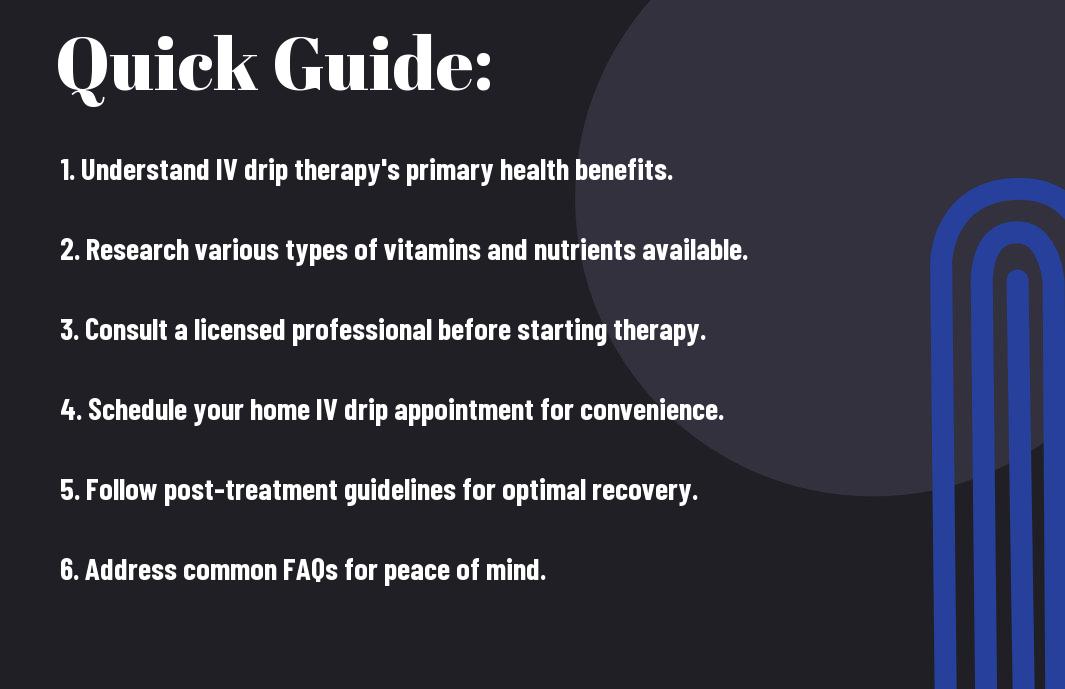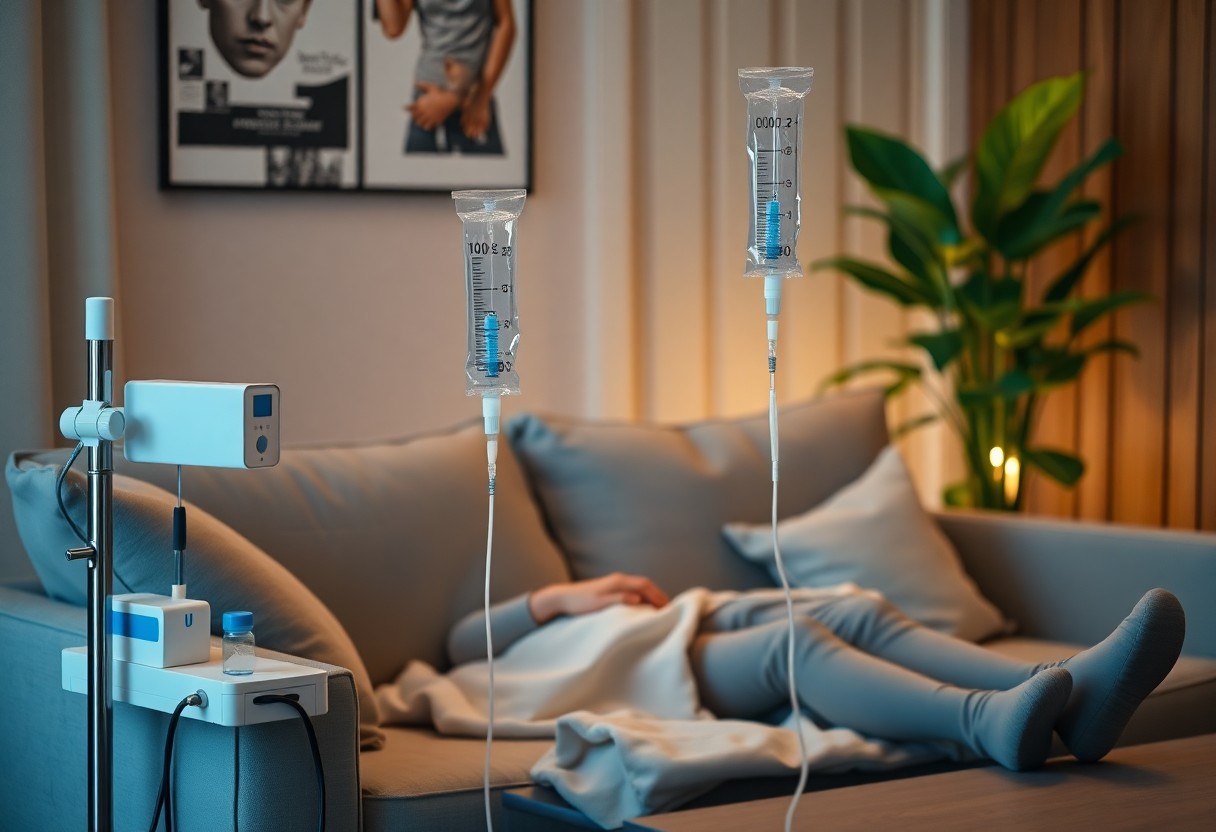Over the years, home IV drip therapy has gained popularity as a convenient and effective way to boost your health and well-being. This guide will walk you through the benefits, potential risks, and frequently asked questions surrounding this innovative treatment. You’ll discover how it can enhance hydration, deliver imperative nutrients, and aid in recovery. By the end, you’ll have the expertise to make informed decisions about incorporating home IV therapy into your routine.

Key Takeaways:
- Convenience: Home IV drip therapy offers a convenient way for individuals to receive hydration and crucial nutrients without the need for hospital visits.
- Tailored Treatments: Nutrient blends can be customized to address specific health needs, enhancing overall well-being.
- Faster Recovery: This type of therapy can facilitate quicker recovery from illnesses, dehydration, or fatigue by delivering nutrients directly into the bloodstream.
- Professional Administration: Home IV therapy should be administered by trained medical professionals to ensure safety and effectiveness.
- Cost Considerations: While it can be an effective option, it’s important to evaluate the cost and insurance coverage before proceeding with home IV drip therapy.

Types of Home IV Drip Therapy
Your journey into home IV drip therapy introduces various types to cater to different health needs. These include:
| Nutritional IV Drips | Focus on delivering vitamins and minerals directly into your bloodstream. |
| Hydration IV Drips | Designed to replenish fluids and electrolytes. |
| Immune Boosting IV Drips | Enhance your body’s natural defenses. |
| Energy IV Drips | Increase your energy levels and combat fatigue. |
| Detox IV Drips | Support your body’s natural detoxification processes. |
Perceiving the various IV drip therapies available can help you determine which best aligns with your needs.
Nutritional IV Drips
While nutritional IV drips provide crucial vitamins and minerals, they also enhance nutrient absorption. This therapy is particularly beneficial for individuals with dietary restrictions or malabsorption issues and can promote overall wellness.
Hydration IV Drips
To feel your best, hydration IV drips are crucial for replenishing lost fluids and electrolytes. They can help revive you after strenuous exercise, illness, or dehydration and can improve mental clarity and physical performance.
Hydration IV drips offer a rapid way to restore electrolyte balance and combat the effects of dehydration. They are particularly beneficial for athletes recovering from intense training or individuals experiencing symptoms of dehydration due to illness or heat. Incorporating hydration directly into your bloodstream helps ensure efficient and quick absorption, leading to immediate feelings of relief and revitalization.

Benefits of Home IV Drip Therapy
Any individual seeking enhanced wellness will find that home IV drip therapy offers a variety of advantages, including improved hydration, increased energy levels, and rapid nutrient absorption. The convenience of receiving tailored treatments at home not only saves time but also provides personalized care. By choosing home IV therapy, you can maintain your health without the stress of frequent clinic visits.
Health Improvements
Health improvements are often immediate and noticeable with home IV drip therapy. You may experience enhanced hydration, better immune system support, and increased overall vitality. This method delivers crucial nutrients directly into your bloodstream, allowing for rapid absorption that can lead to quicker recovery times and increased energy levels.
Convenience and Comfort
Therapy in the comfort of your home offers unmatched convenience. You can schedule appointments that fit your lifestyle, removing the hassle of traveling to a clinic. This personalized approach allows for a relaxed atmosphere where you can unwind and focus on your wellness journey.
Comfort is a significant benefit of home IV drip therapy. With a personalized environment, you can choose where and how you receive your treatment. This means enjoying your favorite activities—like watching TV or relaxing with a book—while receiving crucial nutrients. Additionally, home therapy eliminates the stress of waiting rooms, enabling you to receive care in a familiar setting. In essence, this approach not only prioritizes your health but also enhances your overall comfort during the treatment process.
The Step-by-Step Guide to Home IV Drip Therapy
Now that you’ve decided to explore home IV drip therapy, it’s important to follow a systematic approach for safety and effectiveness. Here’s a breakdown to guide you through the process:
| Step | Description |
| 1 | Consult with a licensed healthcare provider. |
| 2 | Gather all necessary supplies, including the IV drip kit. |
| 3 | Prepare your chosen administration site on the body. |
| 4 | Check for any allergies or contraindications. |
| 5 | Administer the IV drip as instructed. |
| 6 | Monitor your condition throughout the session. |
| 7 | Dispose of all materials safely after use. |
Preparation and Setup
Clearly, preparation is key to ensuring a smooth IV drip experience at home. Start by consulting with your healthcare provider to understand your specific needs. Gather all necessary supplies, such as the IV drip kit, sterile wipes, and disposal materials. Ensure you have a quiet, clean space that’s well-lit for the setup. The area should be comfortable, allowing you to sit or lie down during the procedure.
Administering the IV Drip
Setup your IV drip carefully to maximize its benefits. Outlining the procedure ensures you’re prepared to administer the drip safely. First, locate a suitable vein and swab the area with an antiseptic wipe before inserting the needle. Then, connect the IV bag to the tubing and adjust the flow rate per your healthcare provider’s directions. It’s important to watch for any signs of adverse reactions, such as swelling or pain, immediately notifying your healthcare provider if they occur.
Step by step, administering the IV drip should be approached with confidence. First, you will gently insert the needle into the vein, ensuring proper technique to avoid any *painful complications*. Next, monitor the *drip rate* for effectiveness; a flow rate too fast could lead to discomfort or adverse effects. While administering the IV, keep an eye out for potential problems such as *infection*, redness, or swelling at the site. After completing the drip, safely dispose of materials to prevent any hazardous situations. Your health and safety should always be at the forefront of this process.
Tips for a Successful IV Drip Experience
For a seamless and effective IV drip therapy experience, consider the following tips:
- Stay hydrated before your session.
- Inform your healthcare provider of any allergies or medications.
- Choose a comfortable and quiet space for your treatment.
- Relax and remain calm throughout the infusion.
Assume that following these tips will enhance your overall wellness during home IV therapy.
Selecting the Right IV Drip
To ensure you maximize the benefits of your treatment, selecting the right IV drip is crucial. You should consult with a healthcare professional to determine which blend of vitamins, minerals, and fluids will best suit your specific health needs and goals.
Best Practices for Administration
An effective administration of your IV drip requires attention to detail. Always use sterile equipment, and ensure it’s applied by a qualified individual. Monitor your body’s reactions and adjust the infusion speed to enhance comfort.
Practices such as maintaining a sterile environment can prevent infections. Ensure that all equipment is disposable or properly sterilized. Be mindful of fluid rates and watch for any adverse reactions during therapy—reporting any unusual symptoms immediately can safeguard your health. Incorporating deep breathing or meditation can further enhance your therapeutic experience, turning it into a moment of relaxation and self-care.
Factors to Consider Before Starting Home IV Drip Therapy
Keep in mind various factors before you begin home IV drip therapy. Consider the following:
- Your overall health condition
- The specific nutrients required
- Availability of a qualified provider
- Potential allergies or reactions
After assessing these factors, you can learn more about safe practices in IV Therapy at Home: A Guide to Safe IV Treatments.
Medical History and Conditions
While evaluating your candidacy for IV drip therapy, it’s important to consider your medical history and any existing health conditions. Certain conditions may affect the efficacy and safety of the treatment.
Consultation with Healthcare Providers
An crucial step is consulting with your healthcare providers about starting home IV therapy. Your healthcare professional can evaluate your medical background and advise on whether IV drip therapy is suitable for you.
History shows that discussing your health with a qualified professional can help identify any potential risks or complications, such as reactions to nutrients or interactions with medications. This proactive approach ensures that you can proceed with home IV drip therapy safely and effectively, tailored specifically to meet your individual needs.
Pros and Cons of Home IV Drip Therapy
Despite the growing popularity of home IV drip therapy, there are both advantages and disadvantages to consider before making a decision. Understanding these pros and cons will help you determine if this treatment is the right fit for your health needs.
Pros and Cons
| Pros | Cons |
|---|---|
| Convenience of treatment at home | Potential for infection at insertion site |
| Customized nutrient options | Need for professional administration |
| Improved hydration and vitamin intake | Cost may not be covered by insurance |
| Controlled dosage and absorption | Possible side effects like nausea or dizziness |
| Less waiting time compared to clinics | Limited access to emergency care |
Advantages
You can benefit from the convenience and comfort of receiving IV therapy in your own home. This method allows for greater flexibility in scheduling and eliminates travel time to clinics, making it easier to fit into your daily routine.
Disadvantages
Disadvantages of home IV drip therapy can include potential health risks. You might face issues such as infections at the insertion site or the need for someone trained to administer the drip. Additionally, the costs associated with treatment may be a concern, particularly if insurance does not cover the service.
Drip therapy carries risks that you should weigh carefully. It’s vital to ensure that proper hygiene and sterile techniques are followed to minimize infection risk. You also need to assess whether you have access to immediate medical support in case of any adverse reactions. Ensuring that trained professionals oversee treatments can mitigate some dangers, but the responsibility ultimately lies with you to monitor your health during and after the procedure.
To wrap up
As a reminder, home IV drip therapy offers various benefits, such as improved hydration, enhanced nutrient absorption, and increased energy levels. Understanding the benefits and addressing your FAQs can empower you to make informed decisions about your health and wellness. Whether you’re considering treatment for wellness or recovery, it’s important to work with healthcare professionals to tailor your IV therapy to meet your specific needs. Embrace this innovative health approach to elevate your overall well-being from the comfort of your home.
FAQ
Q: What is home IV drip therapy and how does it work?
A: Home IV drip therapy involves administering fluids, vitamins, and medications directly into the bloodstream through an intravenous line in the comfort of your home. A licensed medical professional usually sets this up, ensuring proper technique and hygiene. The process begins with a consultation to determine the patient’s needs, followed by the preparation of the IV solution and the insertion of an IV catheter. This method allows for faster absorption of nutrients and hydration, making it beneficial for various health conditions.
Q: What are the potential benefits of home IV drip therapy?
A: Home IV drip therapy offers several potential benefits, including enhanced hydration, improved nutrient absorption, increased energy levels, and a quicker recovery from illness. It can also help in managing conditions that require consistent vitamin and mineral replenishment, such as chronic fatigue, migraines, and hangovers. Additionally, the convenience of receiving treatment at home can reduce the stress and time associated with clinic visits.
Q: Are there any risks associated with home IV drip therapy?
A: While home IV drip therapy is generally considered safe when administered by trained professionals, there are some risks involved. These can include infection at the injection site, phlebitis (inflammation of the vein), allergic reactions to the solution, and complications from incorrect technique. To mitigate these risks, it’s crucial to ensure that licensed healthcare providers oversee the procedure and maintain strict hygiene protocols throughout the treatment.
Q: Who should consider home IV drip therapy?
A: Home IV drip therapy is suitable for a variety of individuals, including those who suffer from dehydration, chronic illnesses, sports recovery, or nutrient deficiencies. It can also benefit socially active individuals needing fast recovery from hangovers or fatigue. However, it is important to consult with a healthcare professional to determine if this therapy is appropriate for your specific health needs and conditions.
Q: How often can one receive home IV drip therapy?
A: The frequency of home IV drip therapy varies based on individual health needs and goals. For some, weekly sessions may be beneficial, while others may only require treatment once a month. It is important to have a personalized assessment from a healthcare provider who can recommend the appropriate frequency based on factors such as medical history, lifestyle, and specific therapeutic goals.
